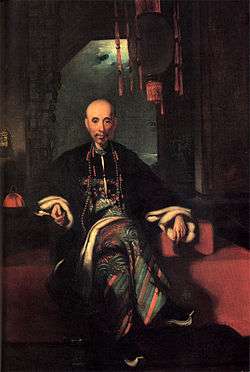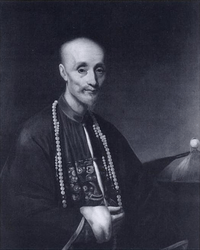Howqua
Wu Bingjian (Chinese: 伍秉鑑)(1769 – 4 September 1843[1]), trading as "Houqua"[2] and better known in the West as "Howqua", was the most important of the hong merchants in the Thirteen Factories, head of the E-wo hong and leader of the Canton Cohong. He was once the richest man in the world.[3][4][5][6]
Howqua | |
|---|---|
 Portrait by George Chinnery, 1830 | |
| Born | Wu Bingjian 1769 Guangzhou, China |
| Died | 4 September 1843 (age 75) Guangzhou China |
| Known for | Founder of Cohong - Ewo (怡和) |
| Net worth | Over $8 billion |
| Children | adopted |
| Howqua | |||||||||||||||||||||||||
|---|---|---|---|---|---|---|---|---|---|---|---|---|---|---|---|---|---|---|---|---|---|---|---|---|---|
 Portrait by Lam Qua | |||||||||||||||||||||||||
| Chinese | 伍秉鑑 | ||||||||||||||||||||||||
| |||||||||||||||||||||||||
| Business name | |||||||||||||||||||||||||
| Chinese | 浩官 | ||||||||||||||||||||||||
| |||||||||||||||||||||||||
Biography
A Hokkien by his paternal ancestry with ancestry from Quanzhou, Wu was known to the West as Howqua, as was his father, Wu Guorong, the founder of the family business or hong. The name "Howqua" is a romanization, in his native Hokkien language, of the business name under which he traded, "浩官" (Pe̍h-ōe-jī: Hō-koaⁿ).[7] He became rich on the trade between China and the British Empire in the middle of the 19th century during the First Opium War. Perhaps the wealthiest man in China during the nineteenth century, Howqua was the senior of the hong merchants in Canton, one of the few authorized to trade silk and porcelain with foreigners. In an 1822 fire which burned down many of the cohongs,[8] the silver that melted allegedly formed a little stream almost two miles in length.[5][6] Of the 3 million dollars of compensation that was required to pay the British from the Treaty of Nanking, he single-handedly contributed one million.[9] He died the same year in Canton.
The founders of then world-renowned firms including James Matheson, William Jardine, Samuel Russell and Abiel Abbot Low all had a close relationship with Howqua. Portraits of the pigtailed Howqua in his robes still hang in Salem and Newport mansions built by US merchants grateful for his assistance.
Legacy
Following the 1842 Treaty of Nanking, which spelled the end of the Thirteen Factories, Jardine Matheson & Co continued to use "Ewo" as their Chinese name.[10]
A settlement on the east bank of Lake Eildon, 23 kilometres (14 mi) from Mansfield, in Victoria, Australia, is named after him, possibly by Chinese miners who passed through the area during the Victorian gold rush.
See also
- Houqua, 1844 clipper ship
References
- Hunt, Freeman; Dana, William B. (1844). The Merchants' Magazine and Commercial Review. Volume 10. p. 459.
- Wong, JDO (2016). Global Trade in the Nineteenth Century: The House of Houqua and the Canton System. Cambridge University Press. ISBN 9781107150669.
- "The Rich and How They Got That Way: How the Wealthiest People of All Time--from Genghis Khan to Bill Gates--Made Their Fortunes". Amazon.ca. 2 October 2018. Retrieved 2 October 2018.
- The Rich And How They Got That Way By Cynthia Crossen Publisher: Crown Publishing Group Pub. Date: 2000 ISBN 0-8129-3267-6
- "中國評論新聞網". Chinareviewnews.com. Retrieved 2 October 2018.
- "晚清的財富精英:1834年的世界首富-閱讀-新浪新聞中心". News.sina.com.tw. Retrieved 2 October 2018.
- zh:廣州十三行
- "3". 觸藩始末 (The Start and End of Upsetting The Foreigners). 1885.
- 档案揭秘:被称为“天下第一大富翁”的伍秉鉴-欢迎进入深圳档案网
- Cheong, W.E. (1997). The Hong merchants of Canton: Chinese merchants in Sino-Western trade. Routledge. ISBN 0-7007-0361-6. p.122 Online version at Google books
External links
| Wikimedia Commons has media related to Howqua. |